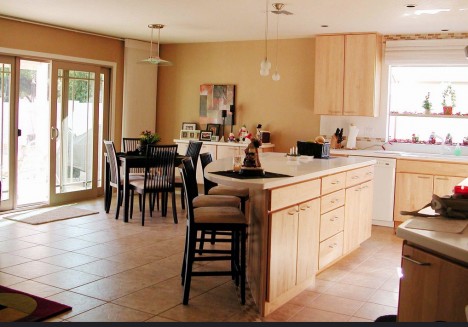
(CC BY-ND 2.0) Nancy Hugo, CKD/Flickr
The American kitchen is a key contributor to America’s lofty obesity rate according to many dietitians and other healthy eating experts. You may very well respond, “Well, duh! Of course. The kitchen is where the food is! You want to lose weight, stay the heck out of your kitchen.”
But it’s not that simple. For one thing, meals produced in your kitchen tend to be healthier, more nutritious, and lower in calories than meals produced commercially, especially those from establishments with drive-thru service. You have far more control over what goes into meals that you produce yourself. While this is not a good thing in every case, at least it usually doesn’t involve deep frying.
It’s the room where diets go to die
The problem with the American kitchen is that it has been gradually redesigned over the years in ways that have made it easier and easier to overconsume whatever food there is in the home. The single major aspect of this evolution is that the kitchen has gotten bigger, more open, and has expanded from a food preparation site to a general hangout site. The typical modern kitchen commonly includes a television and other engaging entertainment technologies, offers plenty of room to gather, and features a breakfast or other dining area.
Weight-loss savant Dr. Brian Wansink strongly recommends making the kitchen less inviting to lounge in. People tend to eat food when food is conveniently close at hand, and the family-friendly kitchen creates exactly that situation. Wansink cites research showing that kids who eat where there is no TV present have lower BMIs than kids who eat while watching the tube.
Too much storage space, too few pantries
Another problem with today’s supersized kitchen is that it includes plenty of storage and shelf space for food. This is inimical to weight control in a couple of ways. First, the more space you have to store food, the more food you are likely to acquire to fill that space, and again, the rule is that the more food that is available to eat, the more food that will in fact be eaten. Second, all of the food in the house is right there, consolidated and within reach of anyone in the kitchen.
Time was, food was stored in a separate area just off the kitchen proper called the pantry. If you wanted to hit the cookies or the corn chips, you had to actually get up and go to another room. Being right next door to the kitchen, this wasn’t a daunting obstacle, but it was better than nothing. Unfortunately, pantries have gone the way of clotheslines and pressure cookers.
Then there’s the sheer openness of the open kitchen. Lots of counter space, and lots of open shelves. Lots of places where packaged food, i.e. bags of chips and cookies and other snack/junk items, can sit conspicuously and invitingly. If you must have unhealthy food items in the home, the golden rule is “Out of sight, out of mind.” Among the factoids unearthed by researchers is that in households where cans or bottles of soda are kept right out in the open, the residents weigh a striking 25 pounds more, on average, than those in which sodas are stashed away.
And finally, there’s the refrigerator. Like the kitchen, it has grown over the years. It now very often has more than just one, or even two, doors. It has a freezer section that cries out to be filled with frozen prepared foods and desserts. There’s ample room for that backup cherry cheesecake or half gallon of rocky road in the event that someone is hit by a sudden craving. A craving that in times past might only be quelled leaving the house and driving to the supermarket at midnight.
And we’re not even gointo to mention all those frozen microwaveable treats and treasures. Don’t even get us started on the subject of the microwave.
There are several measures that persons living with the dietary minefield that is the modern kitchen can take to reduce the negative fallout therefrom. Lacking a pantry, at least put the unhealthy snacks and treats on the higher shelves, and hopefully behind closed cabinet doors, and fill the handy open spaces with bowls of fruit and sugarless beverages. Another nifty factoid: people whose kitchens offer fruit on their countertops weigh an average of 8 pounds less than the fruitless.
Also, a “don’t eat in the kitchen” rule is an excellent idea. Have your family take its meals in a room separate from the kitchen. A dining room is best, especially one with no television to take the diners’ minds off what and how much they are eating, but even a living room or rec room is better. The idea is that when you’ve finished your first helping, at least some modest effort will be required for you to take seconds. Note that this rule is defeated if you take the serving dishes with you to the other room; leave the remaining food in the kitchen.
The general idea is to structure things so that eating, whether complete meals or snacks, is the result of a conscious decision, and not just something that can be done without thought or premeditation because of sheer convenience and availability. In that regard, here’s one more general purpose rule that may not be easy to follow but is worth the effort: don’t spend more than two minutes in your kitchen unless you are either cooking something, or cleaning something.
Good luck.

By Robert S. Wieder, CalorieLab’s Senior Health Columnist since 2006. Author of several books, including 115 Reasons Why It’s Not Your Fault You’re Fat, Bob wrote for numerous national magazines after starting out as editor of the UC Berkeley humor magazine the California Pelican. He also put in a stint as a San Francisco-area stand-up comic.
The Modern American Kitchen Makes Us Fat is a post from:
SOURCE: – Read entire story here.



